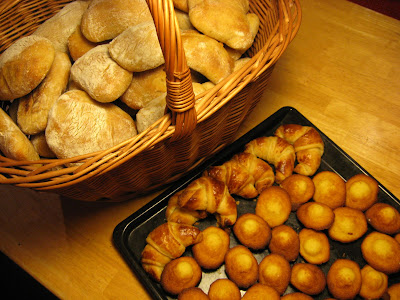As I have mentioned before, our 'moules a la creme' are a rather recent addition to our repertoire.
Before that, my mussels were invariably made the way I had learned them from Odette. Who, in some ways, has to be credited with being the third grandmother who taught me how to cook (the first two being the natural ones).

Our families have been fast friends since around my third birthday, and I have spent many summer holidays in St. Malo in Brittany where they live.
So it was in the dining room of their small terraced house that I got acquainted with all the other things from the sea that you could eat besides fish.
I still vividly remember squatting in the tiny yard with the other children, playing, while in the shadowy house the grown-ups were preparing for dinner. In those memories, Odette is invariably a massive presence, dressed in fearless pink and yellow, with clunky jewellery and long artificial fingernails.
A little bit like a weird aunt serving weird food, both she and her crustaceans held an unusual allure.
Admittedly, most of the food I had to grow accustomed to over the years. The stinky cheeses, the weird innards of crabs and countless other things were tough to sell to a young German boy.
But some dishes I liked quite instantly, one among them the way she prepared her mussels. Much bolder than the rather shy 'moules a la creme', Odette's version comes with heaps of garlic in a slightly hot tomato broth.
With their vibrant taste, these mussels are a pretty perfect way to pick you up when this dull, gray winter weather has worn you down and you just think you need a little jolt to get you going again.

moules aremoricaines
serves two as main, four as a starter
2 kg mussels
2 tablespoons butter
1 onion, chopped
4 cloves of garlic, minced
one bundle parsley, chopped (about one cup)
1 heaped tablespoon flour
2 tablespoons tomato paste
1/2 teaspoon cayenne pepper
0,5 l dry white wine
0,5 l water or tomato puree
optional: a shot glass Pernod or Pastis
Clean the mussels as needed, discarding all the dead or damaged ones.
Once again, we got some galician mussels, but they were oddly clean and not as good as the usual ones. I really wonder why the dirty mussels are always the best ones...
In a large pot, melt the butter and add the onion. Fry until soft, then add the garlic and the parsley. When the garlic is glassy and fragrant, add the flour, stirring until well incorporated.
Odette's version calls for a proper persillade here, which would be half parsley / half garlic and no onion. But as I have co-workers and try not to intrude upon them more than absolutely necessary, I thought reducing the amount of garlic to this manageable amount and adding an onion instead would be only appropriate.
Once the flour has taken up the fat, leave on low heat for another moment. Add the tomato paste and the cayenne pepper and stir until the floor of the pot gets 'foggy', that is until there is a fine layer of the paste sticking to the ground. Swiftly add the wine and the water (and the Pastis, if wanted) and return to strong heat.
If you want to, you can substitute the water for more wine or some tomato puree, whichever you'd like to be more prominent in the final broth.
Bring the broth to a heavy boil, then add the mussels. Cover with a lid and leave on high heat for three to four minutes, stirring once, until all mussels are opened.
If you want to make this dish for children or people who'd prefer to have no residual alcohol in their food, you can leave the broth to boil for a little longer before adding the mussels until the alcohol has evaporated.
Season the broth, if necessary, with more salt or pepper and serve immediately, with crispy white bread and more white wine.
Usually, there is no need to add salt to the broth as the mussels will have added plenty of their own.













